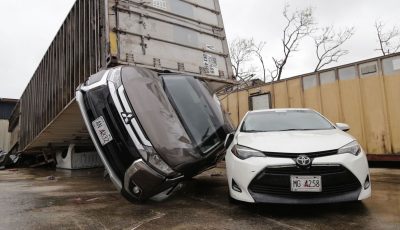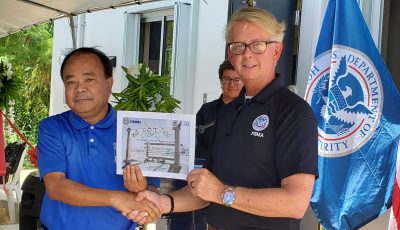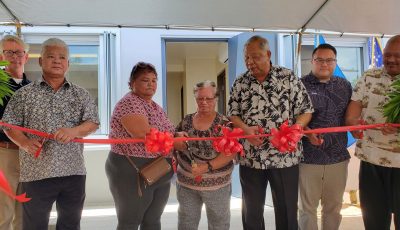STORIES FROM THE SHELTER
Shelter victims call relief efforts ‘too little, too late’
Scenes of Hurricane Katrina victims decrying the slow pace of relief assistance in 2005 is playing anew on Saipan in the wake of Typhoon Soudelor, with majority of the victims calling the relief efforts “too little, too late.”
A visit to temporary shelters over the course of almost two weeks had many of the typhoon victims repeating the same question: “Where is the government in assisting the people?”

Walden Beri, left, with his wife Violeta Lapuz and their son Kalvin Beri, 14, sit on cardboard boxes that also function as their bed at the Office on Aging Center in China Town. (Jayson Camacho)
The CNMI Public School System has opened its campuses for use as shelters, the Department of Community and Cultural Affairs has made available two of its centers for shelters, and the American Red Cross-NMI Chapter has been distributing food for breakfast, lunch, and dinner but it seems these still aren’t enough. Many lack cots, beddings, blankets, containers for water, and access to transportation.
Connie Lizama, 53, her husband, Vicente, 55, and their two grandchildren had sought shelter at Kagman High School during the typhoon. Yesterday, they tried to seek shelter at the Kagman Community Center because even though the Federal Emergency Management Agency and American Red Cross-NMI Chapter had provided them tents and kits, they still need a shelter that has power and water because they are both sick.
“I am disabled, my husband is disabled. I use oxygen at night. He goes to dialysis on Mondays, Wednesdays, and Fridays. Now that I have gone back to my house because the shelter is closed at KHS, we still need to find a shelter for power and water,” Lizama said.
Lizama said she is thankful for all the help that she received but pointed out that it took them a week to receive help and it was only assistance to move back to their house with their tents.
“At KHS we waited for anybody to come and help us but it seems like nobody came to help us. Now, it’s a little late for that. We applied for FEMA and ARC but we need help now,” she said.
She said among the government agencies that responded to them with some sense of urgency was the Commonwealth Healthcare Corp.
“I can stay at the hospital for my oxygen but I can’t stay there by myself because I have two grandchildren and nobody would be with me. So I need a shelter that would have all of us together,” she said.
The Department of Homeland Security and Emergency Management informed Lizama she could call the Commonwealth Office of Transit Authority to give her husband a ride for his dialysis appointment, but she said they still need a place that has power and water.
“We can’t stay at our home. The roof was blown away, my kitchen is gone, and everything is wet,” she said.
Another victim who stayed at Garapan Elementary School last week is also on dialysis. He declined to be identified but said he lost everything. He lives in Oleai.
“Our family has a compound and we lost everything there. We stayed at GES but still we hadn’t had any help. We applied for FEMA and ARC. We even lined up at ARC only to register and not knowing that we were there only for registration,” he said.
Another victim, Walden Beri, 63, who currently stays at the Office on Aging in China Town with his wife, Violeta Lapuz, 55, their son Kalvin, 14, and daughter Kathleen, 23, said they lost everything to Soudelor.
“No one told us it was going to be strong so we stayed home…we lost everything. We only have our passports. …We lost our clothes, shoes, bags, appliances, instrument, and furniture,” Beri, a longtime musician on Saipan, said.
Beri and his family were forced to flee their home in the middle of the typhoon, running for their lives to the church in San Vicente. After the storm, they were rescued and brought to San Vicente Elementary School.
“We didn’t receive help for a long time when we stayed at the shelter. ARC provided food and the shelter helped us but only CHCC came…I am medically referred patient but it was cancelled and I still need help but Medical Referral Office already told us that it would be scheduled for another time,” he said.
Beri, Lapuz, and their children now stay at the Aging on Office. They sleep on cardboard boxes labeled “shrimp flavored crackers.”
“We applied for FEMA already…But if we at least receive help we’d like to request for bed, futon, blankets, pillows, and healthier food because our family has a medical issue—high blood pressure,” Beri said.
Beri said he was grateful that during his stay at SVES, Rep. Edwin K. Propst (Ind-Saipan), the Lion’s Club, and several individuals came to visit them and gave assistance.
“The help was good but it was late, we still need help and we are still waiting,” Beri said.
In the typhoon’s aftermath, U.S. Marines and sailors have been hard at work handing out relief assistance at designated points on the island. However, most shelter victims said they had to drive or walk to the locations that provide the needed food and water.
For those who have lost their homes and are staying in shelters, there is a strong perception that they’ve been pretty much left to fend for themselves. This seems to be consensus among majority of the shelter victims—either those prior to the storm hitting and those that were rescued.
“No one came to our aid,” they would say.
“Where is the help?” was the familiar refrain.
Over 400 victims currently stay in shelters in Tanapag, Garapan, Kagman, San Vicente, China Town, and Koblerville. As of yesterday afternoon, there were 57 typhoon victims at the Kagman Community Center and 104 at the Office on Aging.
DCCA is currently in charge of taking care of those still staying at the shelters, some 10 days after Typhoon Soudelor laid waste to the island.



























